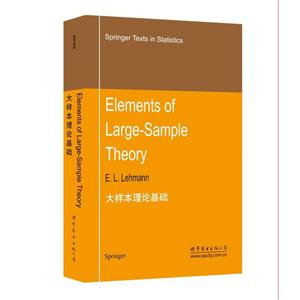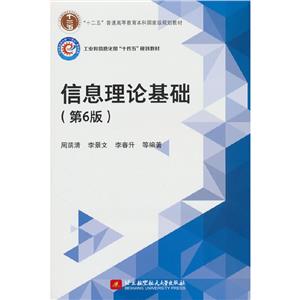Thisbooksystematicallyintroducedthefundamentalsofinformationtheory,focusingonthebasicmodelofcommunicationsystems.Itconsistsof11Chapters,includingtwoparts,namely,basicconceptionsofinforGmationtheoryandrelatedapplicationsofinformationtheory.Thefirstpartcontainsstatisticalmeasureofinformation,discretesource,losslesssourcecodinganddatacompression,discretechannelanditscapacity,channelcoding,whilethesecondpartincludesratedistortion,continuoussource,continuouschannelanditscapacity,maximumentropyandspectrumestimationaswellascomputersimulationexperimentsrelevanttoinformationtheory. Thisbooksummarizedtheexperienceoftheauthorsonteachinginformationcoursein EnglishandChinese,togetherwiththeirunderstandingsfromyearsscientificresearchpractice.Itcanbeusedasteachingmaterialoninformationtheorycourseforbothinternationalundergraduateandgraduatestudents.
Chapter1 Introduction ………………………………………………………………………… 1
1.1 Conceptofinformation ………………………………………………………………… 1
1.2 Historyofinformationtheory ………………………………………………………… 2
1.3 Information,messagesandsignals …………………………………………………… 3
1.4 Communicationsystem model ………………………………………………………… 3
1.5 Informationtheoryapplications ……………………………………………………… 4
1.5.1 Electricalengineering(communicationtheory)………………………………… 4
1.5.2 Computerscience(algorithmiccomplexity) …………………………………… 5
Exercises ……………………………………………………………………………………… 5
Chapter2 StatisticalMeasureofInformation ………………………………………………… 6
2.1 Informationofrandomevents ………………………………………………………… 6
2.1.1 SelfGinformation …………………………………………………………………… 6
2.1.2 ConditionalselfGinformation ……………………………………………………… 6
2.1.3 Mutualinformationofevents …………………………………………………… 7
2.2 Informationofdiscreterandomvariables …………………………………………… 8
2.2.1 Entropyofdiscreterandomvariables …………………………………………… 8
2.2.2 Jointentropy……………………………………………………………………… 11
2.2.3 Conditionalentropy ……………………………………………………………… 11
2.2.4 Mutualinformationofdiscreterandomvariables …………………………… 11
2.3 Relationshipbetweenentropyandmutualinformation …………………………… 11
2.4 Mutualinformationandentropyofcontinuousrandomvariables………………… 12
2.4.1 Mutualinformationofcontinuousrandomvariables ………………………… 12
2.4.2 Entropyofcontinuousrandomvariables ……………………………………… 13
Exercises ……………………………………………………………………………………… 14
Chapter3 DiscreteSourceandItsEntropyRate …………………………………………… 15
3.1 Mathematicalmodelofsource ……………………………………………………… 15
3.1.1 Discretesourceandcontinuoussource ………………………………………… 16
3.1.2 Simplediscretesourceanditsextension ……………………………………… 17
3.1.3 Memorylesssourceandsourcewithmemory ………………………………… 18
3.2 Discretememorylesssource ………………………………………………………… 18
3.2.1 Definition ………………………………………………………………………… 18
3.2.2 Extensionofdiscretesource …………………………………………………… 19
3.3 Discretestationarysource …………………………………………………………… 20
3.3.1 Definition ………………………………………………………………………… 20
3.3.2 Entropyrateofdiscretestationarysource …………………………………… 21
3.4 DiscreteMarkovsource ……………………………………………………………… 24
3.4.1 Markovchain …………………………………………………………………… 24
3.4.2 Transitionprobability …………………………………………………………… 25
3.4.3 Markovsourceanditsentropyrate …………………………………………… 28
Exercises ……………………………………………………………………………………… 31
Chapter4 LosslessSourceCodingandDataCompression ………………………………… 33
4.1 Asymptoticequipartitionpropertyandtypicalsequences ………………………… 33
4.2 Losslesssourcecoding ……………………………………………………………… 34
4.2.1 Encoder …………………………………………………………………………… 34
4.2.2 Blockcode ………………………………………………………………………… 35
4.2.3 Fixedlengthcode………………………………………………………………… 36
4.2.4 Variablelengthcode …………………………………………………………… 42
4.3 Datacompression ……………………………………………………………………… 48
4.3.1 Shannoncoding ………………………………………………………………… 49
4.3.2 Huffmancoding ………………………………………………………………… 50
4.3.3 Fanocoding ……………………………………………………………………… 52
Exercises ……………………………………………………………………………………… 52
Chapter5 DiscreteChannelandItsCapacity ……………………………………………… 54
5.1 Mathematicalmodelofchannel ……………………………………………………… 54
5.2 Discretememorylesschannel ………………………………………………………… 55
5.2.1 Mathematicalmodelofdiscretememorylesschannel ………………………… 55
5.2.2 SimpleDMC ……………………………………………………………………… 56
5.2.3 Extensionofdiscretememorylesschannel …………………………………… 60
5.3 Channelcombination ………………………………………………………………… 65
5.4 Channelcapacity ……………………………………………………………………… 70
5.4.1 Conceptofchannelcapacity …………………………………………………… 70
5.4.2 Channelcapacityofseveralspecialdiscretechannels ………………………… 71
5.4.3 Channelcapacityofsymmetricchannels ……………………………………… 73
5.4.4 ChannelcapacityofextendedDMC …………………………………………… 75
5.4.5 ChannelcapacityofindependentparallelDMC ……………………………… 76
5.4.6 Channelcapacityofthesumchannel…………………………………………… 77
5.4.7 Channelcapacityofgeneraldiscretechannels ………………………………… 78
Exercises ……………………………………………………………………………………… 79
Chapter6 NoisyGchannelCoding ……………………………………………………………… 81
6.1 Probabilityoferror …………………………………………………………………… 81
6.2 Decodingrules ………………………………………………………………………… 83
6.3 Channelcoding ………………………………………………………………………… 84
6.3.1 Simplerepetitioncode …………………………………………………………… 84
6.3.2 Linearcode ……………………………………………………………………… 87
6.4 NoisyGchannelcodingtheorem ……………………………………………………… 91
Exercises ……………………………………………………………………………………… 91
Chapter7 RateDistortion …………………………………………………………………… 93
7.1 Quantization …………………………………………………………………………… 93
7.2 Distortiondefinition…………………………………………………………………… 94
7.2.1 Distortionfunction ……………………………………………………………… 94
7.2.2 MeanGdistortion ………………………………………………………………… 95
7.3 Ratedistortionfunction ……………………………………………………………… 97
7.3.1 Fidelitycriterionforgivenchannel …………………………………………… 97
7.3.2 Definitionofratedistortionfunction…………………………………………… 98
7.3.3 Propertyofratedistortionfunction …………………………………………… 98
7.4 Ratedistortiontheoremandtheconverse ………………………………………… 101
7.5 Thecalculationofratedistortionfunction ………………………………………… 103
Exercises …………………………………………………………………………………… 105
Chapter8 ContinuousSourceandItsEntropyRate ……………………………………… 107
8.1 Continuoussource …………………………………………………………………… 107
8.2 Entropyofcontinuoussource ……………………………………………………… 107
8.3 Maximumentropyofcontinuoussource…………………………………………… 109
8.4 Jointentropy,conditionalentropyandmutualinformationforcontinuous
randomvariables …………………………………………………………………… 109
8.5 Entropyrateofcontinuoussource ………………………………………………… 111
8.6 Ratedistortionforcontinuoussource ……………………………………………… 114
Exercises …………………………………………………………………………………… 117
Chapter9 ContinuousChannelandItsCapacity …………………………………………… 119
9.1 Capacityofcontinuouschannel …………………………………………………… 119
9.1.1 CapacityofdiscreteGtimechannel……………………………………………… 119
9.1.2 CapacityofcontinuousGtimechannel ………………………………………… 120
9.2 TheGaussianchannel ……………………………………………………………… 121
9.3 BandGlimitedchannels ……………………………………………………………… 122
9.4 Codingtheoremforcontinuouschannel …………………………………………… 123
Exercises …………………………………………………………………………………… 124
Chapter10 MaximumEntropyandSpectrumEstimation ………………………………… 125
10.1 Maximumentropyprobabilitydistribution ……………………………………… 125
10.1.1 Maximumentropydistribution ……………………………………………… 125
10.1.2 Examples ……………………………………………………………………… 126
10.2 Maximumentropyspectrumestimation ………………………………………… 127
10.2.1 Burgsmaxentropytheorem ………………………………………………… 127
10.2.2 Maximumentropyspectrumestimation …………………………………… 130
Exercises …………………………………………………………………………………… 137
Chapter11 ExperimentsofInformationTheory …………………………………………… 138
11.1 Measureofinformation …………………………………………………………… 138
11.1.1 Informationcalculator ………………………………………………………… 138
11.1.2 Propertiesofentropy ………………………………………………………… 139
11.2 SimulationofMarkovsource ……………………………………………………… 140
11.3 Performancesimulationforsourcecoding ……………………………………… 141
11.3.1 Shannoncoding ……………………………………………………………… 142
11.3.2 Huffmancoding ……………………………………………………………… 143
11.3.3 Fanocoding …………………………………………………………………… 144
11.4 SimulationofBSC ………………………………………………………………… 144
11.5 Simulationofthecascadechannel ………………………………………………… 145
11.6 Calculationofchannelcapacity …………………………………………………… 148
11.7 Decodingrules ……………………………………………………………………… 149
11.8 Performancedemonstrationofchannelcoding…………………………………… 150
References ……………………………………………………………………………………… 152
















